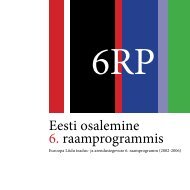Reactive Systems: Modelling, Specification and Verification - Cs.ioc.ee
Reactive Systems: Modelling, Specification and Verification - Cs.ioc.ee
Reactive Systems: Modelling, Specification and Verification - Cs.ioc.ee
You also want an ePaper? Increase the reach of your titles
YUMPU automatically turns print PDFs into web optimized ePapers that Google loves.
42 CHAPTER 3. BEHAVIOURAL EQUIVALENCES<br />
different deadlock behaviour when made to interact with other parallel processes—<br />
a highly undesirable state of affairs.<br />
In light of the above example, we are forced to reject the law<br />
α.(P + Q) = α.P + α.Q ,<br />
which is familiar from the st<strong>and</strong>ard theory of regular languages, for our desired<br />
notion of behavioural equivalence. (Can you s<strong>ee</strong> why?) Therefore we n<strong>ee</strong>d to<br />
refine our notion of equivalence in order to differentiate processes that, like the two<br />
vending machines above, exhibit different reactive behaviour while still having the<br />
same traces.<br />
Exercise 3.2 (Recommended) A completed trace of a process P is a sequence<br />
α1 · · · αk ∈ Act ∗ (k ≥ 0) such that there exists a sequence of transitions<br />
P = P0<br />
α1 α2<br />
αk<br />
→ P1 → P2 · · · Pk−1 → Pk ,<br />
for some P1, . . . , Pk. The completed traces of a process may be s<strong>ee</strong>n as capturing<br />
its deadlock behaviour, as they are precisely the sequences of actions that may lead<br />
the process into a state from which no further action is possible.<br />
1. Do the processes<br />
<strong>and</strong><br />
(CA | CTM) \ {coin, coff<strong>ee</strong>, tea}<br />
(CA | CTM ′ ) \ {coin, coff<strong>ee</strong>, tea}<br />
defined above have the same completed traces?<br />
2. Is it true that if P <strong>and</strong> Q are two CCS processes affording the same completed<br />
traces <strong>and</strong> L is a set of labels, then P \ L <strong>and</strong> Q \ L also have the<br />
same completed traces?<br />
You should, of course, argue for your answers. <br />
3.3 Strong bisimilarity<br />
Our aim in this section will be to present one of the key notions in the theory of<br />
processes, namely strong bisimulation. In order to motivate this notion intuitively,<br />
let us reconsider once more the two processes CTM <strong>and</strong> CTM ′ that we used above<br />
to argue that trace equivalence is not a suitable notion of behavioural equivalence<br />
for reactive systems. The problem was that, as fully formalized in Exercise 3.2, the
















